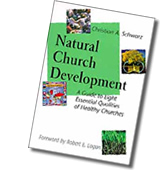What Defines a Healthy Church?
 Through his research, Christian Schwarz, author of Natural Church Development (1996), suggests that there is a correlation between church health and growth. Does church growth equal quantity? Does a church, therefore, need to have the attendance of a mega-church to be successful? Not necessarily. There are many cultic organizations, that do not follow Christian principles, which have massive membership numbers. These numbers are often based on psychological manipulation and force. To those leaders who would follow this worldly method to attain a type of greatness, Christ answers clearly:
Through his research, Christian Schwarz, author of Natural Church Development (1996), suggests that there is a correlation between church health and growth. Does church growth equal quantity? Does a church, therefore, need to have the attendance of a mega-church to be successful? Not necessarily. There are many cultic organizations, that do not follow Christian principles, which have massive membership numbers. These numbers are often based on psychological manipulation and force. To those leaders who would follow this worldly method to attain a type of greatness, Christ answers clearly:
You know that those who are regarded as rulers of the Gentiles lord it over them, and their high officials exercise authority over them. Not so with you. – Mark 10:42-43a
The Christian church is called to a higher standard—Christ’s own standard. We are to be servants and shepherds. It is written:
Your attitude should be the same as that of Christ Jesus: Who, being in very nature God, did not consider equality with God something to be grasped, but made himself nothing, taking the very nature of a servant. – Phil 2:5-7a
How, then, should church leadership promote church growth? Schwarz declares that growth does not have to be forced, but occurs naturally because God designed it that way. Schwarz calls this biotic automatism.
Jesus’ mentions this natural occurrence in many of his parables—the lilies of the field (Matt 6:28), the seed that grows by itself (Mk 4:28), the growth of the mustard seed (Matt 13:31), the four soils (Matt 13:3-8), to name a few. Church growth is, therefore, accomplished by the same principles that a good farmer would use to tend his fields. The farmer measures the pH and the nutrients in the soil; then he tills the soil and applies the right amount of fertilizer to prepare the optimal environment for the seed to grow. Timing and watering are also essential.
Natural church growth is like that. It requires the leadership to measure eight activities (quality characteristics) in the church, and take action to improve those characteristics that are weak so that there exists an optimal environment for growth.
The Eight Quality Characteristics
|
 |
|
When these eight characteristics are balanced, each acts in a complimentary fashion to the others. The weakest characteristic, however, plays a critical role. Using Schwarz’s example, it is like a bucket with staves of different heights. The bucket’s capacity to hold a quantity of water is limited by its shortest stave, which is the minimum factor. Although the bucket staves represent what we should do according to God’s will, Schwarz admits that our industrious improvements in the quality of the vessel cannot cause the water (newly won people) to flow into it. “If God does not send water, even the finest barrel will stay dry” (p53).
Other methodologies focus primarily on evangelism and outreach to attract new visitors. The problem with those methodologies is that an unhealthy environment within the church will eventually destroy the attraction and the new visitors will leave. Focusing on the eight quality characteristics, however, creates a healthy church environment that will both attract and retain new members and enable growth. The model shown here is but one of many.
The Purpose-Driven Model
Rick Warren offers another popular model through his book, The Purpose-Driven Church (1995) in which church health can be evaluated based on purpose. Warren suggests that five purposes can be derived from the Great Commission (Matt 28:19-20) and the Great Commandment (Matt 22:37-40), and together, they describe what the church is to be and do.
When these five purposes are balanced, each acts in a complimentary fashion to the other four purposes and each functions like an organ within a body.
When all of the organs are functioning as they should, the body is said to be healthy. However, if one organ is especially dominant or one organ is especially weak, it can act like a cancer by feeding from the others, further weakening the body. In this case, not only is there no growth, but the body is actually in the process of dying and emergency intensive care is required.
In the second and third chapters of John’s Revelation, the great physician, Jesus Christ, peers at the charts and x-rays of seven churches. He notes what is working, but he also notes what is wrong and that measures must be taken to save the patients.
Pastors: What do the health charts of your church indicate?


